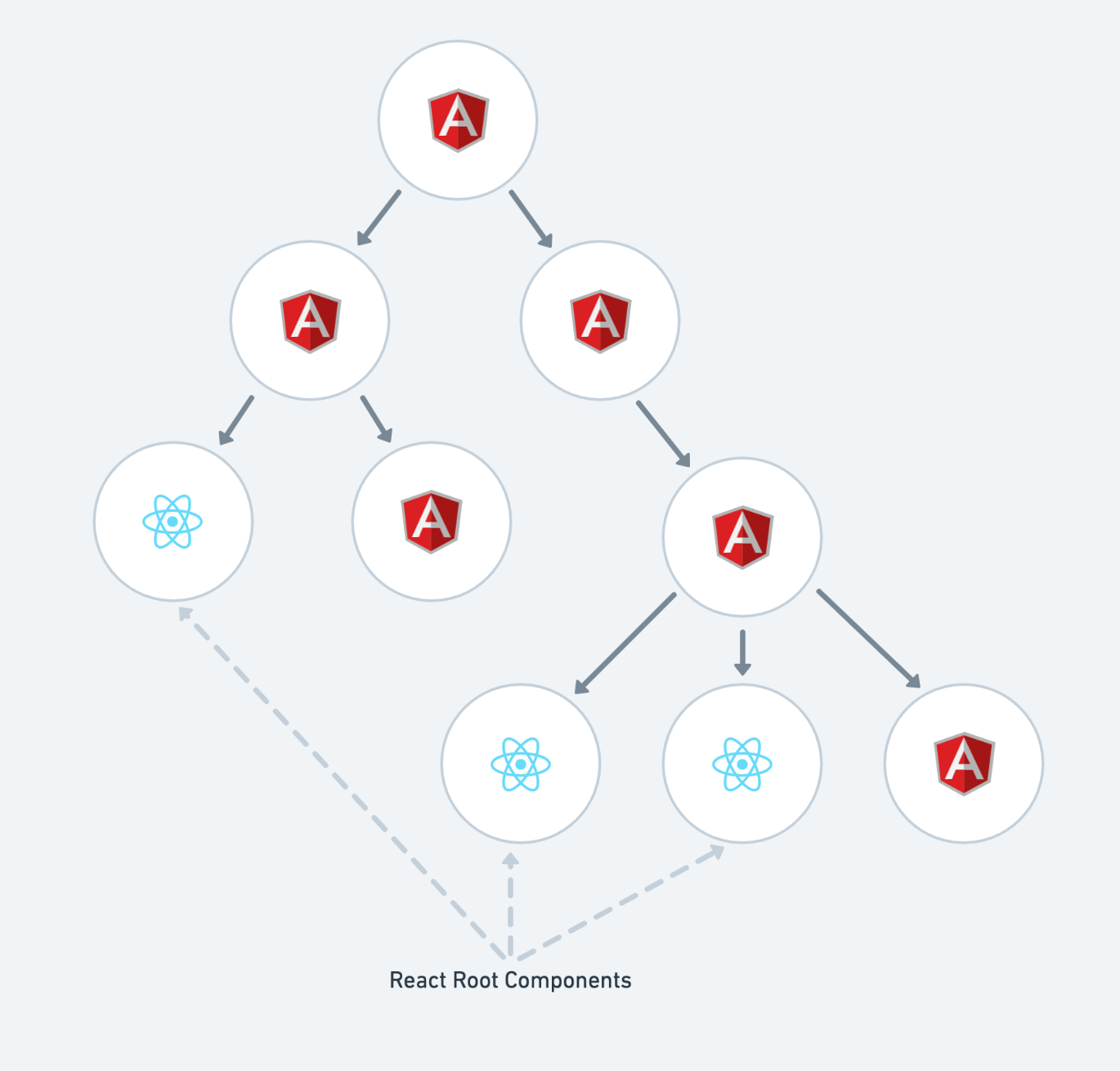Migration to React SeriesMultiple React Roots in AngularJS
Managing multiple React root components in an incremental migration
- Migration to React: Introduction
- Rendering React in AngularJS
- Calling AngularJS Services from React
- Multiple React Roots in AngularJS
One of the biggest challenges with incrementally migrating an app to React is how to manage multiple React “root” components. In a brand new React app, this isn’t a concern, since there’s a single top-level component. If there are any global providers, they're always at the top.
ReactDOM.render(<App />, document.getElementById('root'));
function App() {
return (
<GlobalCacheProvider>
<NotifierProvider>
{/* components */}
</NotifierProvider>
</GlobalCacheProvider>
);
}
The basic setup for a React app
However, in a migration scenario, there are multiple top-level components. Maybe only the user editing screen and product viewing screen have been converted to React. These components will need all the global providers typically found in an App component and may need to access shared state, like app configuration, internationalization, a router or cache.
 An AngularJS app with multiple React root components
An AngularJS app with multiple React root components
An Easy Way to Create React Root Components
When managing multiple React roots, it is important to have an easy way to "Angularize" React components and wrap them in all the global providers. Creating a helper function hides away the complexity of shared state and services when defining a new React root.
The buildReactRoot function is what we'll use to define our new
React root components.
// buildReactRoot.js
import React from 'react';
import GlobalCacheProvider from '...';
import NotifierProvider from '...';
export default function buildReactRoot(
WrappedComponent,
propNames = []
) {
return react2Angular(
({ reactRoot, ...props }) => (
<GlobalCacheProvider cacheService={reactRoot.cacheService}>
<NotifierProvider notifier={reactRoot.notifier}>
<WrappedComponent {...props} />
</NotifierProvider>
</GlobalCacheProvider>
),
propNames,
['reactRoot']
);
}
Let's break this function down.
export default function buildReactRoot(
WrappedComponent,
propNames = []
) {
return react2Angular(
({ reactRoot, ...props }) => (
<GlobalCacheProvider cacheService={reactRoot.cacheService}>
<NotifierProvider notifier={reactRoot.notifier}>
<WrappedComponent {...props} />
</NotifierProvider>
</GlobalCacheProvider>
),
propNames,
['reactRoot']
);
}
We're passing ['reactRoot'] as an argument to react2Angular.
This parameter specifies that the reactRoot Angular Service should
be passed as a prop to the component.
Since we're destructuring the the props, we pass everything else
(other than reactRoot) onto the WrappedComponent. This allows us
to still pass props from Angular code directly to the component.
Let's define the reactRoot service that includes the shared global
services.
// appModule.js
import userModule from './userModule';
import { createCache } from '...';
const cacheService = createCache();
angular
.module('app', [userModule.name])
.factory('reactRoot', (notifier) => {
return {
cacheService,
notifier,
};
});
We used userModule above, but we haven't defined that yet. We'll
build that out next to define a React component with the new React
root setup.
// userModule.js
import React from 'react';
import { react2angular } from 'react2angular';
import buildReactRoot from './buildReactRoot';
// a component that uses the notifier and cache providers
function UserScreen() {
const notifier = useNotifier();
const cache = useCache();
return (
// ...
);
}
// defining the component is just a single line of code!
const userModule = angular.module('userModule', [])
.component('reactUserScreen', buildReactRoot(UserScreen)));
export default userModule;
Now when we use that component in an Angular UI Router state
definition, we treat it as a normal Angular component, and we don't
have to pass any global services to it. reactRoot does all of that
for us behind the scenes.
$stateProvider.state({
name: 'user',
url: '/user',
template: `<react-user-screen></react-user-screen>`,
});
Passing Props from Angular
We can also pass props from Angular by listing them in the component definition.
// userModule.js
// ...
const userModule = angular.module('userModule', [])
.component(
'reactUserScreen',
buildReactRoot(UserScreen, ['currentUser']))
);
Then we can just pass them in like Angular component bindings.
$stateProvider.state({
name: 'user',
url: '/user',
controller: function (currentUser) {
this.currentUser = currentUser;
},
template: `
<react-user-screen
current-user="currentUser"
>
</react-user-screen>
`,
});
Shared State Between Root Components
An important thing to note about having multiple root components is
that global state cannot be held inside React. It could be in the
Angular code or just in a plain function. This is so it can be part
of the reactRoot service, which is passed to each React root
component.
In the above example, the cache service was created in the
appModule.js file and added to reactRoot.
// appModule.js
import userModule from './userModule';
import { createCache } from '...';
const cacheService = createCache();
angular
.module('app', [userModule.name])
.factory('reactRoot', (notifier) => {
return {
cacheService,
notifier,
};
});
Then in buildReactRoot, we passed the cacheService to the
GlobalCacheProvider, which gives each React root access to the
shared service.
export default function buildReactRoot(
WrappedComponent,
propNames = []
) {
return react2Angular(
({ reactRoot, ...props }) => (
<GlobalCacheProvider cacheService={reactRoot.cacheService}>
<NotifierProvider notifier={reactRoot.notifier}>
<WrappedComponent {...props} />
</NotifierProvider>
</GlobalCacheProvider>
),
propNames,
['reactRoot']
);
}
In Summary
- An incremental migration to React requires an easy way to wrap new React root components in global providers.
- A single AngularJS service of all global state and services helps facilitate defining new React root components.
- All global state needs to be held outside of React.


